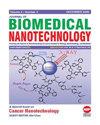Paclitaxel Loaded Hyaluronic Acid Polymerized Nanoparticles Designed for Ovarian Cancer Therapy
IF 2.9
4区 医学
Q1 Medicine
引用次数: 0
Abstract
We aimed to develop an ovarian cancer-directed drug delivery system based on the high affinity of hyaluronic acid for CD44. The effects and mechanisms of hyaluronic acid-containing nanoparticles were investigated. The expression of CD44 in ovarian cancer was also determined. Hyaluronic acid polymerized nanoparticles (HANPs), FITC-HANPs, and paclitaxel (PTX)-HANPs were prepared, and their characteristics were evaluated. The in vitro targetability and cytotoxicity properties of PTX-HANPs were evaluated through in vitro drug uptake and cytotoxicity assays. The mechanisms of PTX-HANPs activity were investigated by apoptosis, wound healing, and Transwell invasion assays. In vivo targeting properties of HANPs were observed using a mouse ID8 subcutaneous model. in vitro experiments revealed an improved uptake of FITC-HANPs. The cytotoxicity of PTX-HANPs in A2780/CP70 and ID8 cells was higher than that of PTX alone. PTX-HANPs increased cell apoptosis in a dose-dependent manner and exhibited a similar ability as PTX to inhibit cell migration. Furthermore, HANPs did not promote A2780/CP70 or ID8 cell migration and showed limited inhibitory effects on their invasion. In vivo drug tracing experiments demonstrated the targetability of FITC-HANPs. In conclusion, PTX-HANPs improved PTX targetability and exhibited potent tumor-specific therapeutic activities. It may be considered a promising formulation for the preclinical development of agents targeting epithelial ovarian cancer.用于卵巢癌治疗的紫杉醇载体透明质酸聚合纳米粒子
我们的目标是开发一种基于透明质酸对CD44高亲和力的卵巢癌靶向药物递送系统。研究了含透明质酸纳米颗粒的作用及其机理。测定CD44在卵巢癌中的表达。制备了透明质酸聚合纳米粒子(HANPs)、FITC-HANPs和紫杉醇(PTX)-HANPs,并对其特性进行了评价。通过体外给药和细胞毒性试验评价PTX-HANPs的体外靶向性和细胞毒性。通过细胞凋亡、伤口愈合和Transwell侵袭试验研究PTX-HANPs活性的机制。利用小鼠ID8皮下模型观察HANPs的体内靶向特性。体外实验显示FITC-HANPs的摄取有所改善。PTX- hanps对A2780/CP70和ID8细胞的细胞毒性高于PTX单独作用。PTX- hanps以剂量依赖的方式增加细胞凋亡,并表现出与PTX相似的抑制细胞迁移的能力。此外,HANPs不促进A2780/CP70或ID8细胞的迁移,对其侵袭的抑制作用有限。体内药物追踪实验证明了FITC-HANPs的靶向性。总之,PTX- hanps提高了PTX的靶向性,并表现出强大的肿瘤特异性治疗活性。它可能被认为是一种有前途的制剂,用于临床前开发靶向上皮性卵巢癌的药物。
本文章由计算机程序翻译,如有差异,请以英文原文为准。
求助全文
约1分钟内获得全文
求助全文
来源期刊
CiteScore
4.30
自引率
17.20%
发文量
145
审稿时长
2.3 months
期刊介绍:
Information not localized

 求助内容:
求助内容: 应助结果提醒方式:
应助结果提醒方式:


